-
Posts
1,025 -
Joined
-
Last visited
Content Type
Profiles
Forums
Store
Help Articles
Posts posted by albiston
-
-
Getting back to Italy, I believe that there is another ragu from Naples "ragu genovese"?
Not exactly. Just "La Genovese", it is not considered a ragu. It's a braised dish of meat and onions (and a few extra secret ingredients
 ) which, like Neapolitan ragu, is used both as pasta sauce –in this case the resulting onion "cream" you get at the end of the long cooking– and as meat main dish.
) which, like Neapolitan ragu, is used both as pasta sauce –in this case the resulting onion "cream" you get at the end of the long cooking– and as meat main dish. -
Alberto, thanks for the recap. It just makes me realize (and nearly everybody else) how rich the restaurant scene is in Italy. I am not the least bit familiar with any of the one-stars you listed, even the one outside of Alba. Also, I never noticed the stars in red. Where do they appear in list form?
I think the red starts are a new idea Michelin tested last year in France, which is being extended to all their guides, to indicate "hot" places which might get an extra star the coming year, or better, it indicates those places Michelin is checking out with particular care for the future edition.
I have to admit I'll add my name to yours in claiming I'm not familiar with some of the one starred places: quite a few of these are scarcely recognised by other Italian guides.
-
As every year Michelin, long awaited is out last (but not least) among the Italian guides.
The complete list of stars and bib gourmands can be downloaded as pdf files directly from the Michelin site, divided by region. For the stars click the link under "Le Stelle" and for the Bib gourmands the link under, ehm, Bib gourmands obviously.
To be honest, no major shake up, although there were gossips of something like this taking place. No three stars demoted (many assumed Al Sorriso would drop to two stars) and one promotion, La Pergola in Rome, bringing Italy's three star total to five. Vissani's absence still seems unexplicable to most Italian foodies and critics.
Continuing, Osteria Francescana in Modena and Il Duomo, in Ragusa, get promoted to two stars. Among the two stars, Perbellini in Isola Rizza gets the, by now famous, red two stars, indicating restaurants that could be promoted in the future to a further star. The "red" one starred establishements are the following: il Gelso di San Martino in Cazzago San Martino (BS), Gambero in Calvisano (BS), Schoeneck in Falzes (BZ) and la Madonnina del Pescatore in Senigallia (AN)
New single starred restaurants: La Pineta in Bibbona (LI), Già Sotto l’Arco in Carovigno (BR), Magnolia in Cesenatico (FC), La Piazzetta in Ferno (VA), Al Porticciolo in Lecco, La Madia in Licata (AG), Il Faro di Capo d’Orso in Maiori (SA), Conti Roero in Monticello d’Alba (CN), Baby dell’Aldovrandi Palace and also L'Altro Mastai in Roma, Zibaldone in San Giorgio in Salici (VR), Casa Grugno in Taormina (ME), L’Birichin in Torino and il Met dell’hotel Metropole in Venezia.
-
I only mentioned the article...not that it was a bible.
I think that Italians also want new ideas.. and that was what this author wrote.( Paola Volpari)
was just following up on ideas for ragu...
for sure there is nothing classic here....
Judy, sorry, I didn't want to sound too harsh. I have to admit the few times I read Sale e Pepe I was always disappointed by the content and so I have no problem admitting I'm biased against them. Nothing personal
 .While being stationed in Naples, Italy, I had the fantastic opportunity to befriend quite a few of the locals there. Once they found out I was a cook, a whole new world opened up to me. One of my observances was, there is NO SUCH THING as the "right" way to make anything (at least in southern Italy)! I truly believe that families have gone to war with each other over the "right" or "wrong" way to make any dish. LOL.
.While being stationed in Naples, Italy, I had the fantastic opportunity to befriend quite a few of the locals there. Once they found out I was a cook, a whole new world opened up to me. One of my observances was, there is NO SUCH THING as the "right" way to make anything (at least in southern Italy)! I truly believe that families have gone to war with each other over the "right" or "wrong" way to make any dish. LOL.While I can agree that there isn't a unique right way to do things when it comes to Italian regional recipes, I would also say that claiming there is "no right way" to cook a recipe is rather short sighted. There might be many familiar variations, yet there always is a general consensus about what a general dish should and should not have and what variations are allowed. People might fight over onions in the sauce for Amatriciana (or Matriciana as Romans call it); ask if cream or peas go in the sauce and everyone will agree that neither should be used.
Let's be honest, if there was "no right way" to make a recipe there'd be little sense in giving recipes out or giving them names at all. The recipes can be fuzzy and difficult to pin down exactly, but at least an ideal concept of what a dish should contain is there.
However, it is my firm belief, that most Napolitani use pork and/or lamb in thier ragu. The pork butt/lamb cooked in the sauce and then sliced as the Secondo Piatto with a little of the sauce over it. OTTIMO!!!! And almost always served over tagliatelle. Thank you for indulging me and my random thoughts.This surprises me a lot, which is not to say I don't believe you. I've lived in Naples over 20 years and have tasted loads of Neapolitan ragu and have a pretty extensive ragu recipe collection: I've never tasted one with lamb, nor served with tagliatelle.Your description makes me wonder if the people who prepared the ragu for you were actually born and raised Neapolitans ir if they came from the areas of Benevento or Avellino, or even the Molise Region.
In Naples lamb is definitely not a popular meat, except during Easter. Tagliatelle, and pasta fresca in general are used so seldom in Neapolitan recipes that you could count the recipes using them on the fingers of one hand: in Naples pasta is almost inevitably the dried durum wheat one. On the other hand both lamb and fresh pasta become more popular the closer you get to the Appennini mountains, and the colder the climate becomes.
-
Ragu variations as per Sale e Pepe November 2005
....
Naples
Lamb shoulder
Pancetta
Garlic
White wine
Chili pepper
Water
Finishing: remove lamb and bone it.
Cheese : Grana Padovana
Pasta: Spaghetti alla Chittara
Judy, sorry to say this, but "Sale e pepe" is not a source I would consider to be very reliable. The Neapolitan in me just rebels at the mention of lamb, WHITE wine, chili pepper and especially spaghetti alla chitarra.
Neapolitan ragu is made traditionally only with pork cuts, be it fresh bacon, sausages, short ribs, or other braising cuts, garlic and onions, RED wine, and, if you want to be traditional, conserva di pomodori, sun dried tomato concentrate, which is unfortunately a rare find today (most people use industrial concentrate).
Most important of all is the pasta: it just HAS to be ziti, broken by hand... maybe smooth penne if you're lazy or cannot find ziti. But chitarra? No-no, that's from Abruzzo.
-
I tried the recipe yesterday and it was a great success, the best home made mapo dofu I've evr knocked together. Thanks hzrt8w!
I'm intrigued by the black beans mentioned by some of you. I definitely would like to try adding some next time. how much would you use?
-
Does anyone, who speaks German, have the time/energy to translate the following for me?
+++++++
I'll try a quick translation
Amuse bouche
Watercress and spice-cured salmon (that's what I take Gewürzlachs to be) terrine with baked oyster, salmon tartare and mussel vinaigrette
Sea bass with octopus and langoustine "haube" (to me that's a bonnet, but I'm sure it must have a different gastronomic meaning), bouillabaisse sauce and grilled cuttlefish
Little chestnuts soup with Alba truffles and sauteed veal sweetbreads
Saddle of pepper-seasoned Fallow Deer with eldeberry jus, salsify, pumpkin-schupfnudeln
Champagne-cream Sorbet „Moët & Chandon“ or Truffled Brie de Meaux with grape mustard (Italian mostarda d'uva maybe?) Sorbet
Pear Clafoutis with pecans, quince, cream and toffee ice
Little pastries
Menü with Champacne sorbet € 130.--
Menü with Brie de Meaux or cheese selection from the trolley € 135.--
* without any of the two above € 105.--
(menu changes could cause changes in the prices mentioned above)
-
Adam, thanks for the intriguing historical information. It's great to know we can rely on your knowledge of Medieval cooking for info
 .
.I wonder if modern day chefs who serve savory zabaglione know of those origins or if they re-invented "caudles" taking inspiration from the sweet version.
History goes round and round.... in the kitchen too.
-
I'm adding a little update on the Gambero Rosso guide: the tre gamberi winning trattorie. Like the three forks for restaurants, these prizes are awarded to the trattorie considered to be "the best" by Gambero Rosso. I noticed that a few of you visited the last year's winner so I thought some of you might appreciate the following list.
Da Amerigo, Savigno (Bologna)
La Brinca, Ne (Genova)
Caffè La Crepa, Isola Dovaresen (Cremona)
Cibus [new entry], Ceglie Messapica (Brindisi)
Locanda al Gambero Rosso, Bagno di Romagna (Forlì-Cesena)
Gostilna Devetak [new entry], Savogna d'Isonzo (Gorizia)
Nangalarruni, Castelbuono (Palermo)
Osteria del Boccondivino, Bra (Cuneo)
Osteria della Villetta, Palazzolo sull'Oglio (Brescia)
Osteria di San Cesario [new entry], San Cesareo (Roma)
La Ragnatela [new entry], Mirano (Venezia)
-
Zabaglione is just the Italian version of Sabayon using Italian wine instead of french.
Or rather, Sabayon is the French version of Zabaglione, which is an Italian dessert. You don't have to take my word for it though
 , those lovable French rascals writing Larousse Gastronomique seem to think it is so, and I am prone to believe them.
, those lovable French rascals writing Larousse Gastronomique seem to think it is so, and I am prone to believe them.I'm a fan of zabaglione made Piedmontese style, i.e. with moscato d'Asti as Marc mentioned before. Personally I find it to be lighter and more refreshing than that made with marsala. Savoiardi biscuits are great with that, but I'd avtually dunk any fruit, cookie or biscuit in zabaglione without an ounce of guilt... and lick the bowl afterwards.
An interesting twist on the classic recipe is savory zabaglione. One could argue if it is still zabaglione at all, though the technique is the same: the wine is substituted with stock, and the sugar either left out or replaced with cheese. Chef Corelli, who was the guest of a chat in the Italy forum some time ago, serves a delicious cheese-less game risotto with a parmesan zanaglione on the side: take a fork of risotto and dunk it in the zabaglione...creamy risotto heavan.
-
I unfortunately have to be the bearer of bad news.
Vittorio Cerea passed away yesterday (Oct 31st) in Bergamo, just a few days after definitely closing Da Vittorio to open La Cantalupa. This is a big loss for Italy's restaurant scene, but hopefully Vittorio's sons will manage to get the new restaurant up and running just as Vittorio would have wanted.
-
I think that's because of the longer cure, right? Sits longer in the salt and takes on a more assertive flavor.
Any particular reason why the cure is longer (or has to be longer maybe) in the US?
-
There are Turkish threads here and in the ME/Africa forum.
Where is Turkey again?

Geography would say part in Europe and part in Asia. Looking at Turkey's desire to get into the EU, I'd say that politicaly it's the former
 .
.Plus you might want to read the title of the thread again... you know, the part about Greece
 .
. -
Host note:
The follow-up discussion on L'Angolo del Paradiso has been moved here.
-
Cool. In Britain they are called 'Minced Pies', although most of the meat content is not included now. I had no idea that any other culture had retained these. Mostly beef tongue or veal was used, but beef was also common.
I had missed the connection with minced pies, so used to considering them a mix of fruit, spices and nuts, that I hadn't thought about them at all. There's quite a bit of meat in these though. I have a recipe from Bonajuto published on a Slow Food book (which I clearly cannot copy here for copyright reasons) which calls for 500 grams of beef tenderloin for every 2.5 kg of stuffing. According to one story we heard in Modica the 'mpanatigghi were one of the tricks used by nuns to get around the prohibition to consume meat during Lent. Once mixed with enough spices and chocolate nobody would notice the nuns were eating meat. I have some doubts on its veridicality, but I like the story anyway.
I wonder, is the origin of the word sweetmeats connected to the same concept?
Great writeup, great photos, great job. And you artfully strung it along to keep us in suspense!
 Thanks, but I'd be lying if I said I planned it all along
Thanks, but I'd be lying if I said I planned it all along  .Thanks for even more great memories, Alberto. Your photos and description from Bonajuto in particular brought back some great ones. I tried the "meat pies" when i was there. They were indeed excellent. I wish I knew to try the cannoli though. That was my particular mission at the time, to have as many cannoli in Sicily as possible. They are excellent in NYC, but even better there.
.Thanks for even more great memories, Alberto. Your photos and description from Bonajuto in particular brought back some great ones. I tried the "meat pies" when i was there. They were indeed excellent. I wish I knew to try the cannoli though. That was my particular mission at the time, to have as many cannoli in Sicily as possible. They are excellent in NYC, but even better there.John, I would have not ordered cannoli at Bonajuto's had I not been tipped of from Katia and Ronald of loveSicily.com after our meal at Il Duomo. I was praising Sultano's mini-cannolo and in reply I was told that to taste a really good cannolo I should try Bonajuto's. The next day I just had to make that my fist stop, though I feared at first I had been fooled. Looking at the price list above the register I could see no sign of cannoli. I asked anyway and the lady serving just gave me a knowing smile and had one made at the moment from one of the pastry cooks. I would have loved to ask why they keep so secret about their cannoli, but I was too busy enjoying the best cannolo of my trip
 .
. -
Host note: the discussion regarding Filipot and dining in Piemonte has been moved here.
-
Noto was our last stop before going home via Catania-Naples (ferry) and Naples-Berlin (bike... just kidding). Although many of the local monuments got damaged in the 1990 earthquake, and reconstruction continues, Noto remains one of the highlights of Sicilian Baroque.
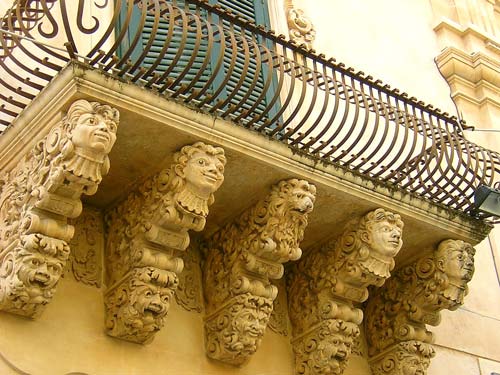
The other reason for visiting Noto was perhaps less profound, but at least more on topic. Noto has two of the most highly prized pastry shops in Sicily, Costanzo and Caffé Sicilia. Costanzo was surprisingly closed for the day, so our hopes of a comparative granita tasting vanished in a puff of smoke. Caffé Sicilia more than made up for the disappointment.

While my wife enjoyed the granita di gelsi (mulberry granita) above - extremely pure and intense mulberry flavor, with just the right balance of fruit acidity and sugar and fantastic texture- I decided to ignore the traditional sweets like cassata and cannoli and have a taste of chef Corrado Assenza's creations. Most are sold as tranci, small single portion cakes, and are based on ricotta and on the jams and infused honey on sale in the shop.
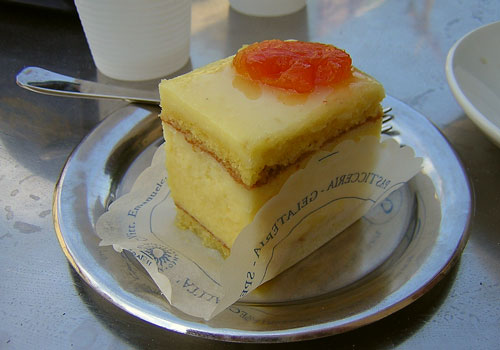
The one I picked, flavored with white pepper and bergamot and topped with a candied apricot, was fantastic. Rich texture and yet absolutely not heavy or tiresome and the flavors dosed with a perfect hand, clear but not overpowering at all (a risk, especially with bergamot IMO). After we had our sightseeing tour I convinced my wife to go back to caffé sicilia and try out another few of chef Assenza's tranci. All very good but the absolute winner was the one with saffron and bitter oranges. If you pass from Noto this is an absolute must.
-
Our last day in Sicily was dedicated mainly to shopping, food and non-food. The hard part about flying by plane when I travel to Italy is having to limit the amount of stuff I can bring back. Somehow there's always just another bottle of wine or cheese that I'd miss at home
 .
.Being Modica famous for its chocolate, which is best described as mexican-style, we could not avoid bringing back home a little collection of differently flavored bars. Both Antica Dolceria Rizza and Bonajuto are good. We really liked the citrus bar from Rizza though Bonajuto's standard bars (cinnamon or vanilla) have a more intense chocolate flavor. Bonajuto also has another advantage: they're arguably the best pastry shop in Modica. The cannoli are simply fantastic (you have to ask for them, because they're made to order) as are the many different almond and carob pastries. What really rocked us though was the 'mpanatigghi, little pockets filled with a mixture of nuts, spices chocolate and beef descending directly from empanadas. These were introduced here by the Spanish religious orders who established monasteries in the city during the times of the Borbón kingdom of the Two Sicilies.
The 'mpanatigghi:
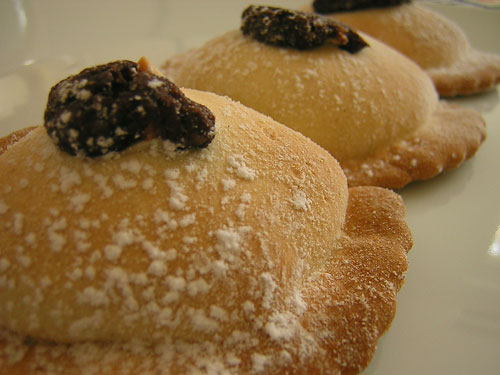
After that we it was the turn of a little base nutrients: cheese and wine, the heart of a healthy diet
 . Smaller Southern Italian cities can have a really depressing choice of wine shops, luckily this is not the case in Modica. Sapori DOC is a small wine shop/bar carrying an impressive collection of Sicilian wines, especially Nero d'Avola bottles. For cheese I followed a tip from the Slow Food website. La Casa del Formaggio is a small shop on Via Tedeschi which I wouldn't have even noticed had I not been looking for it. The cheeses on the other hand are hard to ignore: the owner is an affineur, i.e. he buys the fresh cheeses from selected farmers and ages them himself. There's a huge choice of Caciocavallo Ragusano, from young and unsalted to forms aged well over a year. As it ages Ragusano is first used in cooking, then as table cheese and then grated in everything from pasta dishes to fish.
. Smaller Southern Italian cities can have a really depressing choice of wine shops, luckily this is not the case in Modica. Sapori DOC is a small wine shop/bar carrying an impressive collection of Sicilian wines, especially Nero d'Avola bottles. For cheese I followed a tip from the Slow Food website. La Casa del Formaggio is a small shop on Via Tedeschi which I wouldn't have even noticed had I not been looking for it. The cheeses on the other hand are hard to ignore: the owner is an affineur, i.e. he buys the fresh cheeses from selected farmers and ages them himself. There's a huge choice of Caciocavallo Ragusano, from young and unsalted to forms aged well over a year. As it ages Ragusano is first used in cooking, then as table cheese and then grated in everything from pasta dishes to fish.A slice of 14 month's old ragusano, strong, aromatic and piquant:
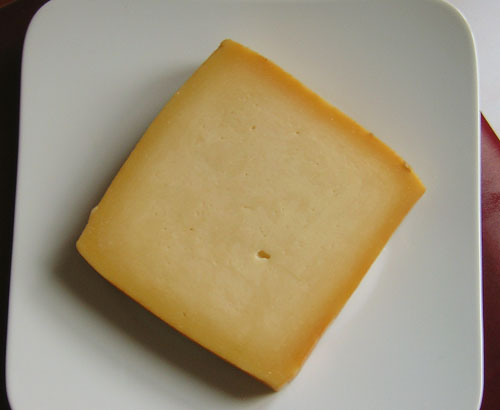
Apart from the classics (ragusano, ricotta salata, scamorze, pecorino) the shop sells two particularly interesting local cheeses. Tuma persa is a rare cheese made by leaving molds develop freely on the unsalted cheese. Once the development has reach the desired stage the forms are salted and aged. The result is a semi-hard cheese with a taste between blue veined cheese and aged Taleggio. The other cheese is tumazzu a cow milk's cheese with pepper grain. While peppered pecorini (sheep cheeses) are common in Sicily, this one is made with a very similar method only using milk from cows of the Modicana race.
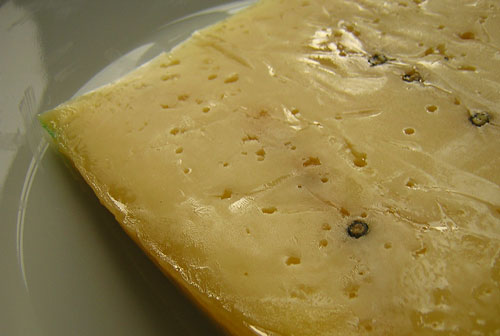
-
The other street food to avoid, IMO, is Currywurst. Unless, that is, you like the idea of a sausage doused in huge amounts of ketchup which is then sprinkled with uncooked curry powder. I know some people here on eGullet have said they actually like the stuff, but I think it's utterliy vile and that a warning about the stuff is in order. This way, if you do order it, you at least have some idea of what to expect.
 Currywurst is exactly as you describe, though it does fill the "one night stand" food niche: something you'll turn to when you've had way too much to drink and something you'll probably regret in the morning. To me it's the equivalent of the British late night Doner Kebab.
Currywurst is exactly as you describe, though it does fill the "one night stand" food niche: something you'll turn to when you've had way too much to drink and something you'll probably regret in the morning. To me it's the equivalent of the British late night Doner Kebab.The Doner Kebabs in Berlin, on the other hand are well worth a try. Hasir in Kreuzberg is a good address.
-
Jordan and grendelyn,
let me first of all welcome you to the eGullet forums, nice to see new faces around.
You both seem to have at least some (and possibly more) experience with Bulgarian cuisine, so I was wondering if there are any typical dishes that should not be missed. Apart the rabbit and the baked cheese, that is
 . Those sound great.
. Those sound great. -
-
Alberto, did you get into the Irpinia region at all?? You probably know where I am going with this...did you stop at La Locanda di Bu??
Unfortunately we had no time for that. It is definitely on my mind though: I'm curious about both Locanda di Bu and Oasis, and there's so many wine producers I'd like to visit there that I just don't know where to start
 . Hopefuly next time.
. Hopefuly next time. -
Alberto...do you know if La Locanda di Bu moved up or down in any of the guides? (also, did Al Vedel get any mentions?)
I know we had an 80 in GR last year. I think we had a 13 in Espresso. If you have time...thanks!
Ore, I have no info regarding points though I would be surprised if Locanda di Bu had not climbed a few points on Gambero Rosso. The reason is simple: the Italian blog "Il Gastronomo Riluttante" published an interesting interview with Mr Perrotta, the editor of the Gambero Rosso restaurant guide. When asked which young chefs could and should catch the attention of the public in the coming year(s) his reply was (my translation):
... in Piedmont I see a highly skilled Davide Palluda. But I would also bet on the restaurants of Fabio Baldassare (l'Altro mastai) or Teresa Buongiorno in Caroligno. In the Avellino province we were very enthusiastic about Antonio Pisianello, but also Adriano Baldassarre of the Tordo Matto in Zagarolo. In provincia di Avellino ci ha entusiasmo moltissimo Antonio Pisianello, ma anche Adriano Baldassare del Tordo Matto a Zagarolo. Others that deserve to be mentioned are Enrico Pezzotti of La Trota, Roberto Petza of S’apposentu, Vito Netti of La Strega a Palagianello, Oliver of the Capri Palace in Capri or Edoardo Ferrera, who after two years as chef at the Don Carlos of the Grand Hotel di Milano has opened his own place, il Gres.The order doesn't necessairly correspond to the score (for example: Enrico Pezzotti of La Trota has 87 and is being tipped off as a possible tre forchette next year), but it certainly shows appreciation for the food and expectations for the future.
I don't know about Al Vedel but I will ask around.
-
Here's an update from the LA Daily News (10 Oct. 2005) on the Mario Batali & Nancy Silverton restaurant partnership:...cut... and next to that Pizzeria del'Latte will feature a wood-fired pizza like that in Rome," says Silverton.
Maybe someone should tell Silverton that most Italians think that Roman-style pizza sucks, except maybe Romans, and I think that's changing too.



A year of Italian cooking
in Italy: Cooking & Baking
Posted · Edited by albiston (log)
Time for someone else picking up where Kevin leaves it, after all there are a few regions missing.
Who's up for a new New Year resolution ?
?